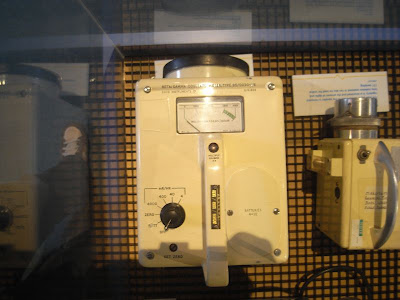I've visited my friend in Sheffield, UK last weekend. We also took a day trip to check out Manchester. How cold two engineers kill a rainy afternoon? By going into the Manchester Museum of Science and Industry (
MOSI) of course. The museum itself has a pretty interesting collection - at least interesting in any technically/scientifically wired brain:)
Unfortunately we only had a couple of hours to fly through the exhibitions. I could recommend a visit there, you could spend a day around all the exciting stuff. We stumbled into a small collection of radiological instruments - mostly from the 70's and 80's. I will post some of them, along with a short description. So here we go:


The one above is my favourite - the big sphere is actually part of the instrument. This is a neutron meter, used to measure the number of neutrons around a reactor or a plutonium store. It was used from the late 60's to the late 70's...

This one above is a vintage beta and gamma dose rate meter from the seventies. Used to measure radiation dose rate in the field or at the workplace.

This is a more interesting one. The one in the middle is a portable air sampler, from the late 60's. The filter paper on the front was removed regularly. It was examined for alpha, beta radiaton and assessed later. Could be used for Iodine 131 monitoring as well.

Here we go onto the more exotic fast neutron meter. This early 60's instrument was used around a nuclear reactor.

This one above is just a regular gamma dose rate meter from the 70's.

And a background radiation monitor, used around nuclear waste in the 70's. It has its readings in counts per second: CPM. I like the cool "gun shaped" design. I wonder wheter it is meant to give readings from a distance...

Here we go onto some film badges. Were worn by workers in the nuclear industry, have been largely replaced by digital, reusable equivalents. The films became more darker as they gathered radiation - this way the dose could be estimated. The one on the right (blue) is actually sensitive to slow neutrons too!
That's all, hope you enjoyed our little tour to "retro" equipment - sorry for the bad quality photos. It was really dark in the whole museum, and this exhibition was no exception...

 I personally think that the style is too patronizing even for young people, the writer treats the reader (even if young) as an idiot, and spells out common sense knowledge, especially in a book about a fairly obscure topic. The worse is yet to come: the text is plagued with the usual "I'm a humanities graduate, so I can afford to write bullshit relating to science" attidude. There is a great deal of inaccuracies, and misleading "facts". I don't recommend it to anyone to be perfectly honest. Oh well, "shift" happens. (owing this pun to Scott Adams)
I personally think that the style is too patronizing even for young people, the writer treats the reader (even if young) as an idiot, and spells out common sense knowledge, especially in a book about a fairly obscure topic. The worse is yet to come: the text is plagued with the usual "I'm a humanities graduate, so I can afford to write bullshit relating to science" attidude. There is a great deal of inaccuracies, and misleading "facts". I don't recommend it to anyone to be perfectly honest. Oh well, "shift" happens. (owing this pun to Scott Adams)













